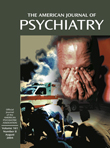To the Editor: We certainly agree with Dr. Dean on the importance of neuroplasticity in recovery from stroke. Cerebrovascular lesions lead to changes in the activation of motor, sensory, and language areas that are associated with behavioral changes and functional recovery
(1–
3). Transcranial magnetic stimulation and functional neuroimaging studies (positron emission tomography and functional magnetic resonance imaging) have been used to demonstrate cortical reorganization after stroke.
The anatomical substrate of these changes entails axonal sprouting of intracortical and interhemispheric projections and synaptic remodeling that might be related to a reactivation of developmental processes triggered by ischemia
(3).
Hippocampal and perhaps prefrontal neurogenesis as well as circuit remodeling in limbic and paralimbic cortices may contribute to ensure an adaptive response to severe stress. On the other hand, disruption of this process may result in the onset of a depressive disorder. We know that antidepressants can influence neuronal plasticity through, for instance, activation of cAMP response element-binding protein and increased expression of neurotrophic factors, particularly brain-derived neurotrophic factor
(4–
6, Santarelli et al., 2003). However, structural plasticity is a complex process that is regulated by different biological cascades and consequently multiple molecular targets.
In addition, proliferation of stem cells in areas like the dentate gyrus or the subventricular zone does not imply the integration of these new neural elements in functional networks. Would CSF levels of brain-derived neurotrophic factor be an adequate biological marker of the efficiency of this process? We don’t know the answer to this question at present.
Our recent findings do not prove the efficacy of administering antidepressants to all stroke survivors. We propose to use this suggestion as a working hypothesis for carefully designed large-scale studies that will, of course, analyze the safety of such intervention.
We acknowledge the increased risk of both bleeding complications and hip fractures for patients treated with SSRIs predominantly during the first few weeks of therapy. This emphasizes the need of strict monitoring and prevention efforts, particularly during the acute and subacute periods
(7–
9). However, given the significant positive effects of antidepressants on functional outcome and mortality, the benefits to be obtained from these medications appear to outweigh the aforementioned risks.
We thank Dr. Sonis for his intense interest in our work. Furthermore, Dr. Sonis brings up an important general point: that possible confounding makes any scientific results tentative until replications are made. We would, however, like to take issue with Dr. Sonis’s suggestion about appropriate and inappropriate methods of assessing confounding and significance.
Dr. Sonis’s suggestions come from an epidemiological perspective, and he notes that we did not take into consideration all possible sources of confounding in our analyses. In one sense, he is absolutely correct. It is impossible to consider all sources of confounding for a variety of reasons. Our sample size was small by epidemiological standards; 104 patients entered the study, and 9 years later, there were 46 patients alive. Estimates of effect size—in this case, odds ratios—will be unstable in this sized sample. Another important consideration is that this was not an epidemiological study; our patients were randomly assigned into antidepressant and placebo groups. The logic of inference differs greatly between a correlational (epidemiological) study and an experimental study such as ours. Dr. Sonis’s suggestions might make more sense for an epidemiological study.
Even if Dr. Sonis’s suggestion of appropriate versus nonappropriate analyses were applicable, we would also like to take issue with his suggestion from a statistical viewpoint. There are two main points here. First, when looking at confounders, Dr. Sonis suggests that it is not the statistical significance of the confounder that matters, but its effect size. This is a potentially dangerous suggestion since random noise can strongly influence the size of an odds ratio, especially in small samples, when base rates are low, or when there are multiple variables involved. In the best of worlds with 40 subjects and just two binary predictors, both at 50:50, there are only 10 subjects in a cell. Not so long ago, statisticians looked at how random fluctuations affect outcomes in such situations and developed the significance test to tell if a particular result was likely a chance variation. Certainly, the size of an odds ratio should be considered, but there should be reasonable assurance that we are not looking at noise.
A second consideration should be noted. Dr. Sonis suggests looking at the “change in estimate.” For large sample studies with stable estimates of the odds ratios and a relatively small number of variables, this makes sense. This suggestion relies on highly complex maximum likelihood estimators of all possible combinations of multivariate relationships. While the “change in estimate” may appear to be a simple suggestion, the actual mathematics behind it can often be extremely opaque, especially when numerous variables are brought in post hoc analyses.
Consequently, we completely agree with Dr. Sonis regarding the need for replication. However, we do not agree with the suggestion for using a change in estimate procedure to speculate about confounders in a randomized study. His suggestions may have more of a place in large epidemiological studies.

